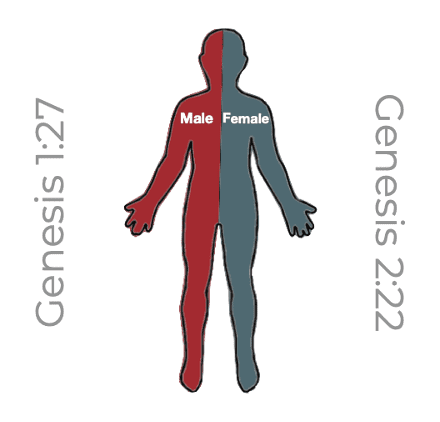This post will not throw Josh Butler under the bus for his article. Josh is a friend of mine and one of my pastors. I have nothing but respect for his character and heart.
This post is not primarily written for Josh, but rather for those who read and are affected by arguments like his. I’m also not going to focus primarily on his conclusions, as disagreeable as they are. Instead, we’ll consider the interpretive approach that led to his conclusions.
Put simply, I highlight fundamental flaws in his argument, specifically his exegesis of Ephesians and Genesis. His logic is made explicit in chapter one of his forthcoming book A Beautiful Union.
For full disclosure, my wife first pointed this out to me; I’ve expounded on her intuition.
If you skim blog articles, I’ll tell you now: the most important sections below are “Ephesians 5 Is Not About Sεx” and “What Josh Misunderstands Genesis 2.” The former is probably the most important of the two.
What Josh Argues
I don’t want to rehash each remark that’s drawn criticism; most people reading this blog will know what he said. Instead, I want to explain how he arrives at those comments.
One reason why it matters is this: his starting point is so broadly accepted but most people don’t realize it. Also, abusers and rapists have used reasoning that sounds remarkably similar to what we find in Josh’s book (though I’m not accusing Josh of criminality).
Josh affirms a basic correlation: the “one flesh” union symbolizes Christ and the church. Few people will disagree with him on that since it’s straight from Ephesians 5.
Where the problem lies in the implications Josh draws from the metaphor. Keep in mind: it’s a metaphor so it’s certainly worthy of debate what its legitimate implications. People want him to disavow various implications he takes from the metaphor.
How do we discern appropriate applications and implications of the text? We pay careful attention to exegesis and theological methods.
How Josh Argues
Josh asserts both “Sεx is an icon of Christ and the church” and “Sεx is an icon of salvation.”[1] He arrives here based on his reading of Ephesians 5. He writes,
In Ephesians 5, a “hall of fame” marriage passage, the apostle Paul proclaims:
“For this reason a man will leave his father and mother and cleave to his wife, and the two will become one flesh.” This is a profound mystery—but I am talking about Christ and the church.
Now, the context here is marriage. “Leave and cleave” is marriage language (we’ll look at this in a future chapter), and the surrounding verses are all about husbands and wives, not hook-up culture. Yet that second part, about the two becoming one flesh, is consummation language that refers to the union of husband and wife.
He adds,
“[one flesh] is the most significant shorthand for sεx in Scripture.”[2]
His argument hangs on the meaning of two ideas: “leave and cleave” and “one flesh.” In my experience, people routinely interpret becoming “one flesh” as a euphemism for sεx. There is some warrant for this, such as 1 Cor 6:16-17,
Do you not know that whoever is united to a prostitute becomes one body with her? For it is said, “The two shall be one flesh.” But anyone united to the Lord becomes one spirit with him.
In both passages, Paul draws from Genesis 2.
Two Preliminary Observations
Just to be thorough, let’s briefly look at Paul’s words. I want to make sure we understand the words being discussed.
First, “cleave” (προσκολλάω) in New Testament and Greek OT does NOT indicate sεxual union. In fact, Israel is told to “hold fast to the Lord your God” (Joshua 23:8). It always connotes clinging to, sticking close, or attaching oneself. Aside from Genesis 2, it does not refer to married couples. (This is true both in Greek and Hebrew.)
Second, the “one flesh” phrasing is more difficult because all uses refer back to Gen 2:24, making it difficult to interpret with precision. I won’t disagree that the meaning of “one flesh” can include sεxual union, but it does not necessarily do so. There’s much more going on.
Ephesians 5 Is Not About Sεx
The linchpin of Josh’s argument is summarized in a 2018 talk he gave at a West Coast TGC conference, where interprets Ephesians 5:31-32 saying, “Paul says here that sεx is a great mystery” (6:50 minute mark). Hold the phone! Paul never ever says this! He says that the relationship between a husband-wife symbolizes the Christ-church relationship. Marriage ≠ sεx.
We can’t do theology without reckoning with metaphors. Josh’s methodological mistake is plain to me: he does not consider the function of the metaphor within Ephesians 5.
Paul’s intention in the passage and in quoting of Genesis 2 has nothing to do with sεx. Again, Ephesians 5:31-32 is not about sεx.
The oneness metaphor, borrowed from Genesis, serves a specific function within the context. From the start, Paul underscores submission (5:21-24). He introduces body imagery where Christ is the “head” and the church is his “body.”
Catch this –> a head and the body make up one flesh, one thing, one whole body. Few things can be more united than a person’s head and the body underneath it. Paul’s purpose is evident in 5:28-29, where Paul speaks of the husband loving his own body (i.e., his wife). Paul seeks to inspire husbands to embrace humble service (“just as Christ does the church,” 5:29).
It’s at this point that we arrive at 5:31-32 (quoting Genesis), which Josh applies to sεx. No.
First of all, Paul quotes all of Gen 2:24, not merely the portion that one might restrict to sεx. As we’ll see below, the whole of Gen 2:24 is about the holistic union between the man and woman (hence the body picture below).
In other words, Paul is simply reinforcing the imagery from the prior verses (i.e., head/body and loving one’s own body) in order to strengthen his call upon husbands to love their wives well.
Verse 32 (“This mystery is profound, and I am saying that it refers to Christ and the church.”) merely intends to unpack how “we are members of [Christ’s] body.” When Paul wrote 5:32, he did not have in mind how 2 bodies have sεx. He intended to underscore how we (his church) ARE his body, not that we are a separate body that is being “penetrated” by Christ (a phrase Josh uses).
What does all this show? Josh errs in inferring from the metaphor various conclusions that don’t fit the original context of Ephesians 5.
Josh Misunderstands Genesis 2
We can go a step further. Josh misunderstands Genesis 2. Genesis 2:22-24 says,
22 And the rib that the Lord God had taken from the man he made into a woman and brought her to the man. Then the man said,
23 “This at last is bone of my bones and flesh of my flesh; this one shall be called Woman, because she was taken out of Man.”
24 Therefore a man shall leave his father and his mother and hold fast to his wife, and they shall become one flesh.
As we’ve seen, “hold fast” language widely points to closeness to (even identification with) someone.
The second part (“one flesh”) might be explained best by verse 23. The language “bone of my bones and flesh of my flesh” widely indicates kinship (e.g., Gen 29:14; 2 Sam 19:12, 13). It would appear that “one flesh” (v. 24) echoes back to v. 23.
Taken together, “hold fast” and “one flesh” suggest that verse 24 simply teaches that the man and woman have an unbreakable kinship union.
Further, the “one flesh” language echoes back to the underlying imagery evident in 2:21-22. I’ve argued for this in a previous post when I explain that “rib” is a wrong translation since it simply means “side.” As a result, Scripture presents humanity as an inseparable unity, depicted by the picture below.
Where does sεx fit into all this? It doesn’t directly. Instead, sεx is but one of many ways that men and women are unified. Marriage is a robustly intimate relationship; sεx is a single aspect of that oneness.
In my opinion, Josh’s interpretive mistakes include the following:
- He does not interpret Gen 2:24 in its fullest context.
- He narrows the language’s meaning (in Gen 2:24) to marriage alone, whereas it could be applied more broadly to close (non-marital) kin relationships.
- He swaps Paul’s metaphors. Whereas marriage symbolizes the relationship between Christ and the church, Josh makes a very specific part of marriage (i.e., sεx) symbolic of the Christ-church relationship.
Not Even Paul Goes There
I’ll conclude with a striking observation. In 1 Corinthians 6:16-17 (quoted above), notice what Paul says after quoting Genesis 2,
“But anyone united to the Lord becomes one spirit with him.”
Paul is careful and explicit not to use sεxual language with describing our union with Christ. Being united to the Lord means becoming one ἓν πνεῦμά (in spirit).
I’m not sure fully what to make of this (as it applies to Josh’s book and article), but I will say this— metaphors are a critical and essential part of the biblical message, but we should err on being minimalists when it comes to teasing out their implications. We must not treat a part (sεx) for the whole (marriage).
NOTE: Why the apple image above? I think it represents so much of what’s going on here. First, Josh is a godly, humble lover of God and people. Yet, he’s written something that most people find repulsive. Second, Josh tries to exalt biblical truth but ties it with problematic theological methods. We too have a choice. Will we separate the person from his mistakes? Will we labor to separate sound exegesis from poor theologizing?
[1] A Beautiful Union, p. 4.
[2] A Beautiful Union, p. 6.















